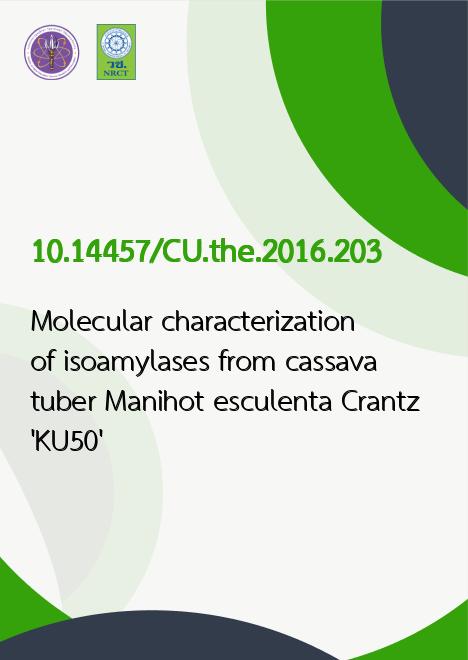
|
Molecular characterization of isoamylases from cassava tuber Manihot esculenta Crantz ‘KU50’ |
|---|---|
| รหัสดีโอไอ | |
| Title | Molecular characterization of isoamylases from cassava tuber Manihot esculenta Crantz ‘KU50’ |
| Creator | Pawinee Panpetch |
| Contributor | Tipaporn Limpaseni, Robert A. Field |
| Publisher | Chulalongkorn University |
| Publication Year | 2559 |
| Keyword | Plant enzymes, Cassava, เอนไซม์พืช, มันสำปะหลัง |
| Abstract | Starch debranching enzyme or isoamylase (EC.3.2.1.68), an important enzyme in starch metabolism, catalyses the hydrolysis of α-1,6 glycosidic linkages of amylopectin. In this work, cassava isoamylase genes were isolated from cDNA generated from total RNA from tubers of Manihot esculanta Crantz cultivar KU50 by RT-PCR and analysed by agarose gel electrophoresis. Three putative isoamylase genes, MeISA1, MeISA2 and MeISA3 were identified and amplified excluding the fragments encoding their transit peptides. Full length of MeISA3 gene was obtained by 5’ Rapid Amplification of cDNA Ends (5’ RACE). The mature MeISA1 and MeISA2 were successfully amplified and cloned into a pETDuet1 vector, while the mature MeISA3 was amplified and cloned into a pET21b and sequenced. The ORFs of mature recombinant MeISA1, MeISA2 and MeISA3 genes were 2,292, 2,649 and 2,127 kb, encoding 763, 882 and 708 amino acid with substantial similarity to StISA1, StISA2 and StISA3 from potato at 84.4%, 68.9% and 80.9%, respectively. Then, rMeISA1 and rMeISA2 were coexpressed and rMeISA3 was single expressed in Escherichia coli SoluBL21(DE3) and purified by HistrapTM column. Analysis by SDS-PAGE and immunoblot showed approximate molecular weights of 87, 99, and 80 kDa, respectively. Debranching activity was only detectable in the fractions where both rMeISA1 and rMeISA2 were present. The heteromultimeric DBE from 4-5 h induced culture analysed by gel filtration chromatography and Western blot showed combinations of rMeISA1 and rMeISA2 at ratios of 1:1 to 1:4. Pooled fractions of rMeISA1/rMeISA2 with DBE activity and the purified rMeISA3 were used for enzyme characterisation. Both rMeISA1/rMeISA2 and rMeISA3 showed the optimum activity at 37ºC but their optimum pH were at 7.0 and 6.0, respectively. Enzyme activity of rMeISA1/rMeISA2 was enhanced by Co2+, Mg2+ and Ca2+, whereas rMeISA3 activity could be significantly activated by Mn2+ and Co2+. Cu2+ was a strong inhibitor for both enzymes. Debranched amylopectin products analysed by HPACE-PAD showed chain length distributions typical of plant debranching enzymes with DP from 6 to 20 with major products around DP 10 to 12. rMeISA1/rMeISA2 were specific for amylopectin while rMeISA3 showed the highest activity on beta-limit dextrin. However, they could hardly hydrolyse pullulan at all, indicating their classification as isoamylase-type debranching enzyme. The debranching activity of rMeISA1 and rMeISA2 required their association as heteromeric complexes. |
| URL Website | cuir.car.chula.ac.th |